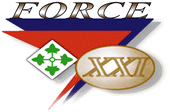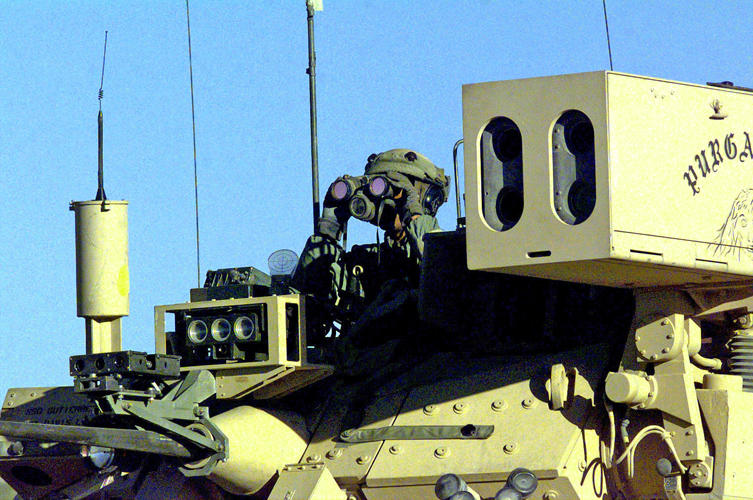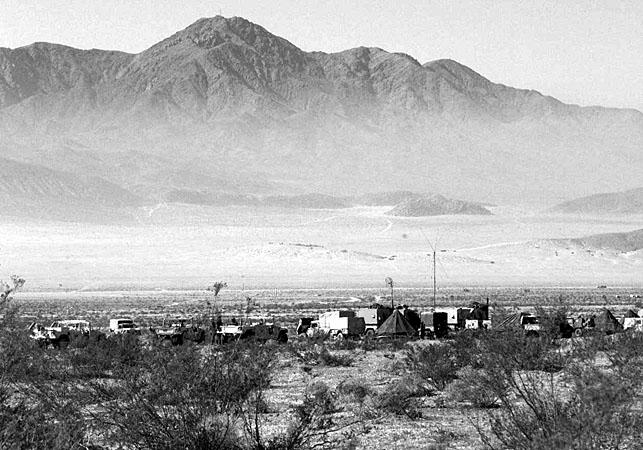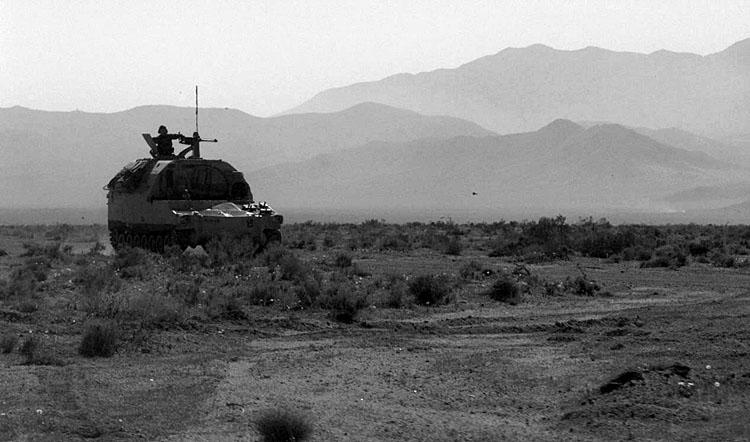![]() 1st Battalion 22nd Infantry
1st Battalion 22nd Infantry ![]()
EXFOR Exercises March 1997



Photo from the National Archives: Record Group 330
Editor's note:
In the 1990's the US Army experimented with new
technology designed to radically change the performance
of ground units on the battlefield. The 4th Infantry Division
(Mechanized) was selected as the Army's test Division,
and within the 4th Division the 1st Brigade received the initial
equipment and technology.
As part of that Brigade, the 1st
Battalion 22nd Infantry became the Army's first fully
digitized Battalion,
and was involved in the testing and application of the new
technology, eventually becoming the first to use it in combat,
during Operation Iraqi Freedom in 2003.
During the 1990's the 1st Brigade 4th Infantry
Division became known as EXFOR (Experimental Force), testing and
experimenting with the new technology,
and devising new tactics and strategies for employing it on
combat operations.
The Army's Digital Experiment
by Mark Hanna (Number 119, July 1997)
The First Digitized Ground Force
A large step toward Information Age war-fighting was completed in March at the Army's National Training Center (NTC), Fort Irwin, Calif. The Army's Experimental Force (EXFOR)-the world's first digitized ground force, the 1st Brigade, 4th Infantry Division (Mechanized)-deployed to the harsh conditions of the Mojave Desert at Ft. Irwin for an intensive, realistic war-fighting exercise against the NTC's vaunted Opposing Force (OPFOR), the 11th Armored Cavalry Regiment. The exercise was the culminating event of the TF XXI Advanced Warfighting Experiment (AWE)-a key part of the Army's Force XXI process of continuous experimentation and transformation which will result in Army XXI-the digitized force for the 21st Century.
Digitizing ground forces will enhance situational awareness by providing accurate, complete, real-time information about friendly and enemy forces. The idea is to cut through the fog of battle to achieve information dominance over the enemy. The EXFOR was outfitted with communications systems and computers capable of acquiring, exchanging and employing digital information throughout the battlefield. Every vehicle and dismounted element in the EXFOR had a constantly updated digital monitor depicting all friendly force and known enemy force locations. The technology's potential is that it should lead to increased lethality, survivability and operating tempo for a digital force. The AWE's object was to find ways of exploiting that potential.
The Force XXI Process
The Army's Force XXI process involves three complementary and interactive efforts designed to reshape the current force into Army XXI, the digitized force for the 21st Century:
Advanced Warfighting Experiments-the key events of JOINT VENTURE-test hypotheses concerning future Information Age warfighting capabilities. The TF XXI AWE, which began in early 1996 and culminated at the NTC in March 1997, is the fifth and most ambitious AWE since they began in 1994. A Division XXI AWE is under way and will culminate in a simulation exercise this fall. The Army will use the results of the AWEs as it prepares to organize, train, and operate Army XXI sometime after the year 2000.
The Experimental Force
The EXFOR is a Brigade Combat Team (BCT) built around the 1st Brigade of the 4th Infantry Division (Mech.). Its 5,000 soldiers are assigned to mechanized infantry, light infantry, armor, field artillery, aviation, and engineer battalions, a reconnaissance troop, and supporting elements. The EXFOR has tested organizational and operational concepts, training, and equipment and is assessing enhancements in lethality, survivability, operational tempo, sustainability, and versatility. The EXFOR has been integrating digital equipment and training at Fort Hood, Texas since early 1996. Training has included state-of-the-art virtual computer exercises, and a series of field exercises including a brigade-on-brigade opposing force exercise at Fort Hood in December 1996.
The EXFOR experimented with 72 different initiatives (including operational concepts and equipment prototypes) during the AWE. The NTC exercise was closely monitored by experienced observer/controllers and high technology instrumentation which monitors and records locations, movements and engagements and virtually everything that happens during the battle. The advantage of the NTC as a test environment is that it is the Army's most realistic and challenging exercises and battle results are captured and recorded with almost 100% resolution.

More than 7,000 Force XXI troops
and 2,000 vehicles traveled to the Army's National Training
Center at Fort Irwin, Calif.,
to test information age technology designed for the 21st century.
Linda D. Kozaryn
The Tactical Internet and the Digitization Challenge
Digitizing and equipping the EXFOR for the TF XXI AWE was a monumental effort. The EXFOR received over 7,000 individual pieces of equipment with over 900 vehicles modified into over 180 different configurations. Digital appliques, consisting of a computer and GPS locator, were mounted on all vehicles and wired into a communications system of Army radios which were reengineered to handle more digital traffic. The challenge of making this work, is comparable to operating and maintaining a 30-story office building's worth of communications and computer networks while mobilized on a battlefield, exposed to hostile fire, difficult terrain, and weather extremes.
This communications infrastructure, called the Tactical Internet (TI), is the central feature and key element of the digitized force. It is a tactical, integrated system of computers, radios, satellite terminals, switches and software which constantly passes information, both horizontally and vertically, automatically and on-demand, throughout the task force. Friendly locations are automatically transmitted and downloaded to the network. Enemy locations, identified through unmanned aerial vehicles (UAVs), the Joint Surveillance Target Attack Radar System (JSTARS), spot reports from reconnaissance elements, and other means, are also downloaded to the network. The result is an accurate, constantly updated picture of the battlefield shared throughout the force.
Equipping the EXFOR for the TF XXI experiment required streamlining the acquisition and fielding process. The process involved extensive and unpre-cedented use of commercial technologies and service-contractor cooperation. Building the Tactical Internet required integrating the efforts of 48 different contractor vendors and extensive use of contractor personnel and soldiers working in teams. This effort coordinated and supervised by the EXFOR's Central Training Support Facility (CTSF) at Fort Hood is becoming a model for Army-Industry cooperation.
Emerging Insights
Several insights have emerged from EXFOR training-up exercises and earlier digital experiments.
Friendly situational awareness works well-soldiers like it; and the commanders' ability to fight the battle is also significantly enhanced. However, high resolution and accuracy concerning the enemy situation is more difficult to achieve. The idea is to identify enemy locations and activity and get the information into the system in real time. JSTARs, UAVs and the new Brigade Recon Troop have proven to be effective intelligence gatherers. The process of fusing enemy information from many sources (including spot reports) and getting it into the system in real time remains a challenge.
Appliqued packages and the Tactical Internet will need further development especially in the use of available band width and signal frequency management. The TI served to test the concepts of TF XXI but it was not intended to, and has not, developed the final product in terms of hardware. Initially, three versions of the vehicle-mounted applique were fielded-one result; the $20,000 ruggedized personal computer performed as well as the $100,000 military specifications model.
Horizontal integration of the digital systems has not been as smooth as vertical integration. Much of the TI's hardware and software was acquired by different organizations at different times. Originally designed to function vertically through the chain of command, this tactical "system-of-systems" has presented challenges to horizontal integration.
The TI is apparently far more useful to higher commanders than to soldiers and leaders at the point of contact. Although the TI is an effective command and control tool, soldiers and leaders in the midst of battle have little time to interface with their appliques. Immediate voice communication remains critically important, especially during an engagement. Voice communications give commanders a "feel for the battle" allowing a subordinate to convey urgency, and for a commander to gauge urgency, through voice inflections.
Power requirements for dismounted infantry appliques presents problems. This system, which includes a laptop and helmet-mounted eye piece, requires 70 lbs. of batteries for 24 hours of operations-too much for the already overloaded light infantryman.
Observations
Forcing systems integration, through the CTSF at Fort Hood, eliminated stovepipe systems and facilitated partnering among the various programs. The common technical architecture established by the Army Digitization Office also helps systems integration.
Network software and procedures must determine what information goes to whom and when. They must also specify what information, or databases, are accessible by which users. Doctrine and operating procedures should provide the answers to these crucial questions, but the optimum doctrinal answer may be constrained by available system bandwidth. As bandwidth becomes less constrained, technology and doctrine will have to evolve simultaneously and cooperatively so that neither constrains the optimum solution.

An ammunition vehicle moves
across the Mojave Desert sand and scrub brush during the Army's
Force XXI warfighting experiment.
Linda D. Kozaryn
TF XXI NTC Exercise Results
Results from the recently completed TF XXI NTC exercise are still being analyzed, but preliminary reports support the insights and observations described above. Friendly situational awareness and aerial surveillance of the OPFOR worked well and presented the EXFOR with some excellent battlefield opportunities. Opportunities were not always exploited, probably due to a lack of experience with the new technology. The enemy situation picture was not always as accurate and timely as desired, indicating that improvements are needed in the fusion and dissemination of intelligence inputs from different sources. The TI was sometimes overloaded with information and message traffic, indicating a need for better network management and a continuing maturation of bandwidth and digital integration capabilities. The exercise was a success in demonstrating the value of digitization and pointing the way for further development of the technology and operating procedures necessary to exploit its potential.
Conclusion
The TF XXI AWE successfully demonstrated the potential for digital technology to increase the lethality, survivability, and operating tempo of ground forces. Information overload, systems integration, and network management will improve as hardware, software, and operating procedures develop and mature.
More training and experience with the new technology will allow ground force units to maximize its capabilities and potential. The AWE experimental process itself has emerged as a clear winner, substantially reducing the time and expense required to integrate new technology. Underlying the Army's entire digital experiment was the question of how to best gain and exploit information dominance on future battlefields. The TF XXI AWE will help the Army to determine how to organize, equip, operate, communicate, and lead forces-empowering, but not encumbering, them with information technology.
The Army's Force XXI process will continue with the Division-level experiment culminating in late 1997. Lessons learned from these experiments will be applied as the Army begins to field more digitized units beginning in the year 2000. The recently completed Quadrennial Defense Review (QDR) provides funds to accelerate the fielding of the first digitized Force XXI Corps.
About the Paper
This paper is the result of a trip to Fort Hood and the developing TF XXI by a National Defense University group including MG John S. Cowings, Commandant of the Industrial College of the Armed Forces, and Dr. Hans Binnendijk, Director of INSS. The author, LTC Mark Hanna also followed the results of the March 1997 AWE at Fort Irwin's National Training Center. Fore more information contact LTC Hanna at 202-685-4245 ext. 843, by fax at 202-685-4272, or by e-mail at hannam@ndu.edu.
The above paper was taken from the
National
Defense University
Institute for National Strategic Studies
Home | Photos | Battles & History | Current |
Rosters & Reports | Medal of Honor | Killed
in Action |
Personnel Locator | Commanders | Station
List | Campaigns |
Honors | Insignia & Memorabilia | 4-42
Artillery | Taps |
What's New | Editorial | Links |